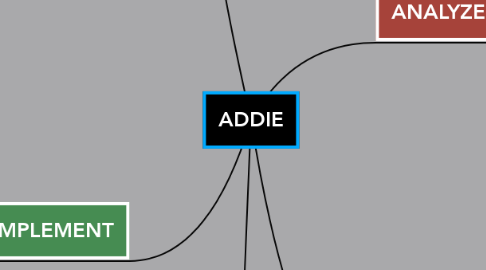ADDIE
by John Fraser

1. EVALUATE
1.1. Complete formative assessment of design during each phase of the ADDIE process.
1.2. Conduct summative assessment to review user feedback and identify potential gaps or new learner needs.
1.3. Assess whether objectives are achieved through the learning experience.
1.4. Change learning assets or media as required to meet learner needs.
1.5. Apply feedback to the ANALYZE phase to identify and implement new objectives that support the success of the learning experience.
2. IMPLEMENT
2.1. Add completed learning experience to Learning Management System (LMS).
2.2. Train learning facilitators as required.
2.3. Register students and execute course completion parameters.
2.4. Collect learner feedback and monitor for ease of access and technology performance issues.
2.5. Confirm evaluation standards for formative/summative learning assessments.
3. DEVELOP
3.1. Finalize all course content.
3.2. Apply technology to design assets based on storyboard, prototype testing.
3.3. Create polished course using appropriate graphics, media, and style choices that support content.
3.4. Complete iterative process of evaluation related to debugging and ease of access.
3.5. Revise course structure and learning materials based on continuous evaluation process.
4. Create the content and assets of the learning experience based on the decisions made in the DESIGN phase.
5. Share the finished product of the DEVELOP phase with instructors and learners in a live environment.
6. Complete ongoing assessment of the entire design process with respect to quality and effectiveness, in relation to the outcomes defined in the ANALYZE phase.
7. DESIGN
7.1. Determine terminal and supporting learning objectives based on the identified goal of learning.
7.2. Document the project's instructional, technical, and visual strategy.
7.3. Apply instructional models that support intended outcomes (behaviorist, cognitive, constructivist).
7.4. Create a course storyboard, develop a prototype.
7.5. Select learning materials and determine appropriate formative/summative assessments for learners.
8. ANALYZE
8.1. Determine the desired end result of the learning experience.
8.2. Identify the target audience and existing knowledge of learners.
8.3. Decide on the most effective learning approaches/learning theories.
8.4. Determine the desired delivery method (eLearning, classroom, blended).
8.5. Identify timelines and deadlines for completion.
9. Clarify the instructional problem and identify desired learning outcomes in consideration of audience, training methodologies, and delivery options.
10. Identify and select appropriate learning strategies based on the goals and considerations defined in the ANALYZE phase.


